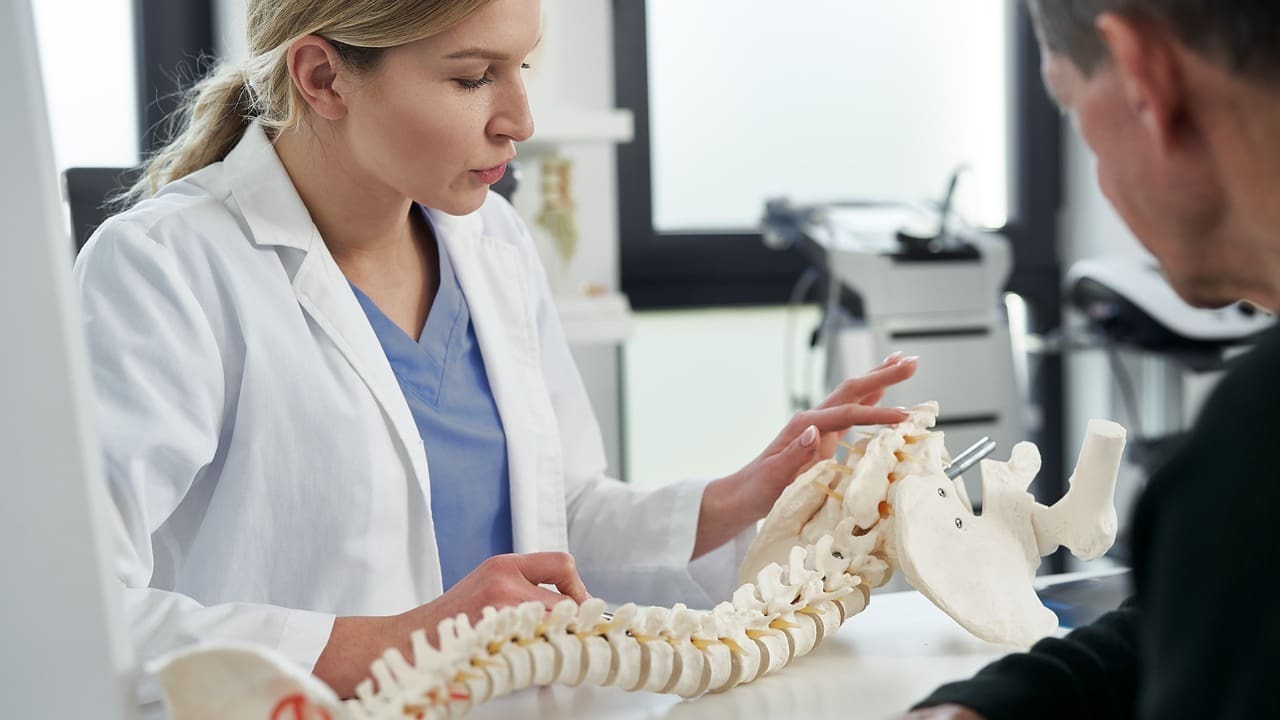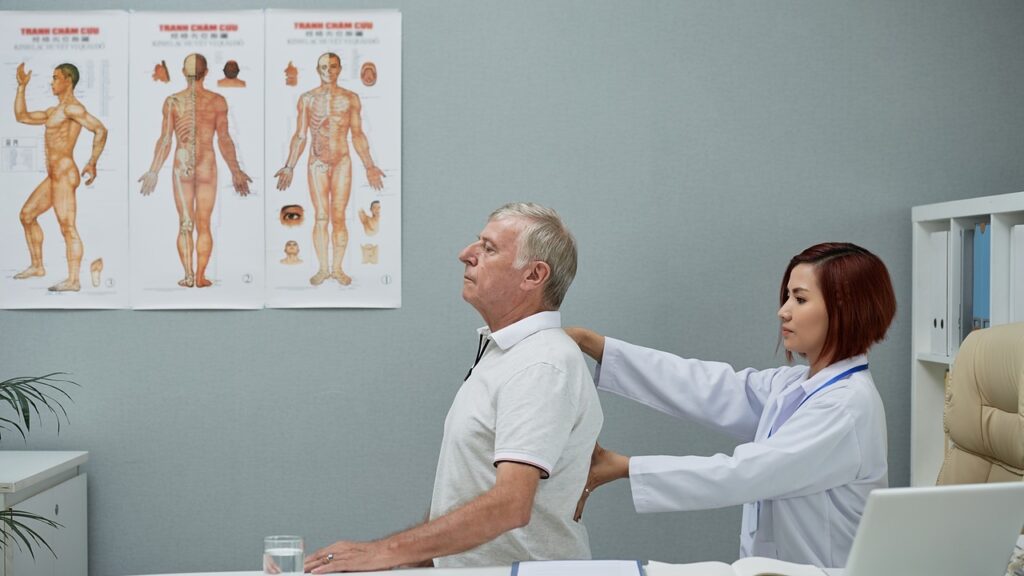Last Updated on November 4, 2025 by Bilal Hasdemir

If you have arthritis of the spine, surgery might change your life. At Liv Hospital, we use the latest in spine surgery. This includes decompression and spinal fusion to ease pain and boost function. Knowing your options is key to choosing the right care for you.
Thinking about surgery for back pain? We’re here to help. Our team will guide you every step of the way. We’re dedicated to top-notch healthcare and support for patients from around the world.

Spinal arthritis affects millions, causing pain and disability. We’ll look at the types, their effects, and when surgery is needed.
Spinal arthritis includes osteoarthritis, rheumatoid arthritis, and ankylosing spondylitis. Osteoarthritis wears down joints and discs, causing pain and stiffness.
| Type of Spinal Arthritis | Impact on Patients |
|---|---|
| Osteoarthritis | Wear and tear on joints and discs, causing pain and stiffness |
| Rheumatoid Arthritis | Inflammation and degeneration of joints, leading to pain and limited mobility |
| Ankylosing Spondylitis | Chronic inflammation, leading to fusion of vertebrae and limited mobility |
First, we try physical therapy, medication, and lifestyle changes. But if these don’t work, surgery might be next. We’ll talk about when and how surgery is done.
If treatments don’t help, and pain or mobility issues persist, surgery is considered. Surgery aims to ease pain, stabilize the spine, and improve life quality. We’ll look at options like decompression, fusion, and artificial disc replacement.

Arthritis of the spine surgery aims to ease pain and boost spinal function. It’s key to grasp the many aspects of surgery for spinal arthritis. This helps ensure the best results for patients.
The main goals of spinal arthritis surgery are to ease nerve pressure, stabilize the spine, and improve function. Surgery can greatly enhance a patient’s life if other treatments fail. We use different methods like decompression, fusion, and stabilization to achieve these goals.
Deciding if surgery is right for a patient involves a detailed check-up. We look at their health, arthritis severity, and recovery chances. Age, medical history, and lifestyle also play a role in this decision. This careful evaluation helps us pick the best surgery for each patient.
Before surgery, patients go through several checks to get ready. These include imaging, lab tests, and talks with our team. We also offer advice on how to prepare, like changing your lifestyle and managing medications. This helps reduce risks and improve surgery results.
| Preoperative Assessment | Description | Purpose |
|---|---|---|
| Imaging Studies | X-rays, MRI, or CT scans | To visualize the spine and assess the extent of arthritis |
| Laboratory Tests | Blood work and other diagnostic tests | To evaluate overall health and identify potential risks |
| Medical Consultations | Discussions with our medical team | To address concerns, answer questions, and plan for postoperative care |
Laminectomy and decompression surgeries help relieve pressure on spinal nerves. This improves symptoms and function in patients with spinal arthritis. These surgeries aim to reduce nerve compression in the spine, which can lead to pain, numbness, and weakness.
A laminectomy removes part or all of the lamina, a bony structure in the spine. This creates more space for nerves. It helps relieve pressure on spinal nerves caused by arthritis. This procedure is often used to treat spinal stenosis, a narrowing of the spinal canal.
Foraminotomy is a surgical technique to decompress spinal nerves. It widens the foramina, the openings for nerve roots to exit the spinal canal. This is helpful for patients with nerve root compression due to arthritis or disc herniation. By enlarging the foramina, foraminotomy reduces nerve root pressure, easing pain and improving function.
The recovery time for laminectomy and decompression varies by patient and surgery extent. Patients often see significant symptom improvement within weeks to months after surgery. Here’s a summary of the typical recovery and outcomes:
| Recovery Stage | Timeline | Expected Outcomes |
|---|---|---|
| Immediate Post-Surgery | 0-2 weeks | Pain reduction, improved mobility |
| Early Recovery | 2-6 weeks | Gradual return to normal activities |
| Late Recovery | 6-12 weeks | Significant improvement in symptoms, enhanced functional ability |
Understanding laminectomy and decompression procedures helps patients make informed treatment choices. We aim to provide comprehensive care and support throughout the surgical journey. Our goal is to ensure the best outcomes for our patients.
Spinal fusion surgery is a key treatment for advanced osteoarthritis of the spine. It fuses two or more vertebrae together. This helps stabilize the spine and reduces pain.
We will look at different aspects of spinal fusion surgery. This includes traditional methods, instrumentation, and long-term results.
Traditional spinal fusion removes damaged discs or vertebrae. It replaces them with a bone graft. This graft can come from the patient or a donor.
The graft is held in place with rods, screws, or plates. These methods help achieve stability and promote fusion.
The choice of instrumentation and bone grafting depends on the patient’s condition. Modern tools provide quick stability, allowing for faster recovery.
Bone grafting has improved with new materials and techniques. These advancements help increase fusion rates and reduce recovery time.
Spinal fusion surgery greatly improves life for those with advanced arthritis. Long-term, patients often see less pain and better mobility.
However, patients must adjust their lifestyle after surgery. This includes physical therapy and avoiding certain activities. We help patients understand the benefits and implications of spinal fusion.
Understanding spinal fusion surgery helps patients make informed choices. It offers a hopeful solution for those with advanced osteoarthritis. It aims to make life more stable and pain-free.
Minimally invasive surgery has changed how we treat lower back arthritis. It allows for quicker healing and less damage to tissues. Now, we have various procedures tailored to meet the needs of those with this condition.
Endoscopic decompression is a key minimally invasive method. It uses a small endoscope and special tools to relieve nerve pressure. Tubular decompression, meanwhile, uses a system to access the spine with little disruption to tissues.
Both methods aim to reduce the harm of traditional surgery. They lead to less pain and faster healing. Research shows that patients see big improvements in their symptoms and life quality.
Minimally invasive surgery for lower back arthritis offers many advantages. These include:
“Minimally invasive spine surgery represents a significant advancement in the treatment of spinal disorders, offering patients a viable alternative to traditional open surgery.”
Minimally invasive surgery leads to faster recovery compared to traditional methods. Patients can usually get back to their normal activities in a few weeks.
| Recovery Aspect | Minimally Invasive Surgery | Traditional Surgery |
|---|---|---|
| Hospital Stay | 1-2 days | 3-5 days |
| Recovery Time | 2-6 weeks | 6-12 weeks |
| Postoperative Pain | Less | More |
We see minimally invasive surgical options as a big step forward in treating lower back arthritis. They offer both effectiveness and quicker recovery times.
Cervical spine surgery is an option for those with neck arthritis who haven’t seen relief from other treatments. Neck arthritis can really affect your daily life, causing pain and making it hard to move. If other treatments don’t work, surgery might be needed to help you feel better and move easier.
Anterior Cervical Discectomy and Fusion (ACDF) is a common surgery for neck arthritis. It involves taking out the bad disc and joining the vertebrae together to stabilize the spine. ACDF works well for herniated discs, degenerative disc disease, and spinal stenosis. It helps by taking pressure off the spinal cord and nerves, which can lessen pain and improve movement.
For those with cervical spondylosis, back-of-the-neck surgeries might be suggested. These surgeries get to the spine from the back to ease pressure on the spinal cord or nerves. Laminectomy or laminoplasty can help by making more room for the nerves, which can reduce pain and improve function.
It’s important to have clear expectations about recovery after neck surgery. We recommend a structured rehab program to help you get the best results. The time it takes to recover can vary based on the surgery and your health. Most people see big improvements a few weeks to months after surgery.
Here are some key things to keep in mind:
By knowing what to expect and following the post-op advice, you can get the most out of your surgery and have a smoother recovery.
Artificial disc replacement is a big deal for those with spinal arthritis. It keeps the spine moving, unlike fusion surgery which can freeze it. This new surgery is all about keeping the spine flexible.
Artificial disc replacement has come a long way. It helps with both neck and lower back pain. Cervical disc replacement fixes neck pain, while lumbar disc replacement tackles lower back issues. These surgeries swap out the old disc for a new one that moves like the real thing.
Newer artificial discs are getting better. They last longer and move more like our natural discs.
Artificial disc replacement keeps the spine moving. Fusion surgery, on the other hand, fuses two vertebrae together. This means less stress on other discs and fewer long-term problems.
People who get artificial disc replacement often heal faster. The surgery is less invasive, causing less damage and pain.
Finding the right person for artificial disc replacement is key. Those with single-level disc disease who haven’t gotten better with other treatments are usually a good fit. They should also have a relatively healthy spine.
Most people do well with artificial disc replacement in the long run. They feel less pain and can move better. But, like any surgery, there are risks. Regular check-ups are important to make sure the disc lasts.
It’s important to know the risks of spine surgery before making a decision. Spine surgery, like any big surgery, has risks that can affect how well it works.
Common problems include infection, nerve damage, and when the hardware fails. Infection is a risk with any surgery, and antibiotics help lower this risk. Nerve damage is a big worry because the spine and nerves are closely connected.
Long-term issues might be chronic pain, hardware failure, or problems with the segments next to the surgery site. Patients should know that revision surgery might be needed to fix these problems.
| Complication | Description | Management |
|---|---|---|
| Infection | Bacterial infection post-surgery | Antibiotics, wound care |
| Nerve Damage | Damage to spinal nerves during surgery | Monitoring, potential revision surgery |
| Hardware Failure | Failure of implanted hardware | Revision surgery |
Success depends on the patient’s health, the surgery’s technique, and care after surgery. A multidisciplinary approach to care can greatly improve results.
It’s key to know the different surgeries for arthritis in the spine to make good choices. We’ve looked at several spine surgery options. These include discectomy, spinal fusion, kyphoplasty, laminectomy, and artificial disc replacement. Each has its own use and benefits.
When thinking about arthritis in spine treatment, you need to look at how bad your condition is. You also need to think about if surgery will help. For example, spinal fusion might be good for those with severe degenerative disc disease or spinal instability.
On the other hand, discectomy or laminectomy could be better for people with herniated discs or spinal stenosis. If you have osteoarthritis back treatment, artificial disc replacement might be a good choice. It’s a way to keep your spine moving without fusion surgery.
Deciding to have spine in surgery should always be a team effort. Talk to a healthcare professional about your condition and what you hope to achieve. This way, you can make a choice that’s right for you.
Knowing about the different surgeries and what they can do helps patients make smart choices. It ensures they get the best care for their specific needs.
Spinal arthritis is when the joints and discs in the spine get inflamed and degenerate. This leads to pain, stiffness, and less mobility. It can really affect your daily life. We’re here to help you find treatment options.
Surgery is considered when other treatments don’t work and the condition really impacts your life. We look at each case to decide the best treatment.
Surgery aims to ease pressure on nerves, stabilize the spine, and improve mobility. We tailor our approach to meet each patient’s needs for the best results.
Laminectomy removes part or all of the lamina to open up the spinal canal. This relieves nerve pressure. It can greatly improve symptoms and quality of life for those with spinal stenosis or other conditions.
Spinal fusion surgery fuses vertebrae together to stabilize the spine. It can offer long-term relief but comes with risks like complications and limited mobility. We carefully check if this procedure is right for each patient.
Minimally invasive techniques, like endoscopic and tubular decompression, are less invasive than traditional surgery. They can lead to quicker recovery times and less scarring.
Artificial disc replacement replaces a damaged disc with an artificial one. It keeps the spine mobile and reduces the risk of further problems. This option is good for those who want to keep moving freely.
Like any surgery, there are risks such as infection, nerve damage, or hardware failure. We take all precautions to minimize these risks and ensure the best outcomes for our patients.
We assess each patient’s condition, medical history, and overall health to see if surgery is right. Our team works closely with patients to understand their needs and create a personalized treatment plan.
Recovery times vary based on the procedure and individual factors. We provide personalized guidance and support to help ensure a smooth recovery and the best outcomes.
We work closely with patients to manage their expectations and understand the surgical process, recovery, and potential outcomes. Our goal is to ensure patients are well-informed and prepared for their journey.
Spinal fusion surgery can offer long-term relief and stability for patients with spinal arthritis. However, it’s important to understand the potential implications and lifestyle considerations. We discuss these factors with patients to ensure they’re well-prepared.
While some cases of osteoarthritis of the spine can be managed without surgery, surgery may be needed in more severe cases or when other treatments fail. We evaluate each patient’s condition to determine the best treatment.
Osteoarthritis of the spine and degenerative arthritis of the spine involve degeneration of the spine. While often used interchangeably, degenerative arthritis can include a broader range of changes. We help patients understand their specific condition and develop an effective treatment plan.
https://www.spine-health.com/treatment/back-surgery/types-lumbar-spine-surgeries-what-you-need-know
Subscribe to our e-newsletter to stay informed about the latest innovations in the world of health and exclusive offers!
WhatsApp us